 W
WBibliotheca selecta is a bibliographical encyclopedia by the Jesuit Antonio Possevino, printed in two folio volumes at the Typographia Apostolica Vaticana by Domenico Basa in 1593. It represents an authoritative and up-to-date Jesuit compendium of Counter-Reformation knowledge.
 W
WBrevis commentarius de Islandia is a book in Latin written and published in Denmark in 1593 by the Icelandic scholar Arngrímur Jónsson. It is a "Defense of Iceland", in which he criticized the works of numerous authors who had written about the people and the country of Iceland. His main target was a poem by Gories Peerse, a merchant who had written an entertaining and somewhat slanderous poem about Icelandic geography and ethnography. Arngrímur also criticized substantial works such as Cosmographia universalis of the German scholar Sebastian Münster.
 W
WChronica Polonorum is a treaty about Polish history and geography written in Latin by a Polish renaissance scholar Maciej Miechowita, a professor of Jagiellonian University, historian, geographer, astrologer, and royal physician of king Zygmunt I the Old. Chronica Polonorum was first published in 1519.
 W
WThe Davidiad is the name of a neo-Latin heroic epic poem by the Croatian national poet and Renaissance humanist Marko Marulić. Likely finished in AD 1517, the poem, as its Latin title suggests, details the ascension and deeds of David, the second king of the United Kingdom of Israel and Judah, who is said to have reigned c. 1010–970 BC.
 W
WDe humani corporis fabrica libri septem is a set of books on human anatomy written by Andreas Vesalius (1514–1564) and published in 1543. It was a major advance in the history of anatomy over the long-dominant work of Galen, and presented itself as such.
 W
WDe moribus tartarorum, lituanorum et moscorum is a 16th-century Latin treatise by Michalo Lituanus. The work, which was originally dedicated to King of Poland and Grand Duke of Lithuania Sigismund II Augustus, survived only in ten fragments that were first published in 1615 by Johann Jacob Grasser in Basel, Switzerland.
 W
WDe Natura Fossilium is a scientific text written by Georg Bauer also known as Georgius Agricola, first published in 1546. The book represents the first scientific attempt to categorize minerals, rocks and sediments since the publication of Pliny's Natural History. This text along with Agricola's other works including De Re Metallica compose the earliest comprehensive "scientific" approach to mineralogy, mining, and geological science.
 W
WDe optimo senatore was a book by Wawrzyniec Grzymała Goślicki published in Venice in 1568, republished in Basel (1593), and then translated into English and published in 1598 and in 1607.
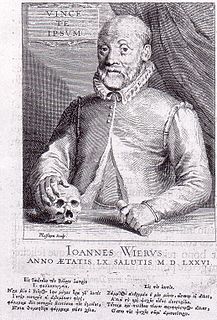 W
WDe praestigiis daemonum, translated as On the Tricks of Demons, is a book by medical doctor Johann Weyer, also known as Wier, first published in Basel in 1563. The book argues that witchcraft does not exist and that those who claim to practice it are suffering from delusions, which should be treated as mental illnesses, rather than punished as witchcraft. It was influential in the abolishment of witchcraft trials in the Netherlands.
 W
WDe re metallica is a book in Latin cataloguing the state of the art of mining, refining, and smelting metals, published a year posthumously in 1556 due to a delay in preparing woodcuts for the text. The author was Georg Bauer, whose pen name was the Latinized Georgius Agricola. The book remained the authoritative text on mining for 180 years after its publication. It was also an important chemistry text for the period and is significant in the history of chemistry.
 W
WDe revolutionibus orbium coelestium is the seminal work on the heliocentric theory of the astronomer Nicolaus Copernicus (1473–1543) of the Polish Renaissance. The book, first printed in 1543 in Nuremberg, Holy Roman Empire, offered an alternative model of the universe to Ptolemy's geocentric system, which had been widely accepted since ancient times.
 W
WDefensio Tridentinæ fidei is a 716 page book first published in Lisbon, in 1578, written by Diogo de Payva de Andrada in response to Martin Chemnitz's Examen Concilii Tridentini (1565–73).
 W
WHistoria de Gentibus Septentrionalibus was a monumental work by Olaus Magnus on the Nordic countries, printed in Rome 1555. It was a work which long remained for the rest of Europe the authority on Swedish matters. Its popularity increased by the numerous woodcuts of people and their customs, amazing the rest of Europe. It is still today a valuable repertory of much curious information in regard to Scandinavian customs and folklore.
 W
WThe Education of a Christian Prince is a Renaissance "how-to" book for princes, by Desiderius Erasmus, which advises the reader on how to be a good Christian prince. The book was dedicated to Prince Charles, who later became Habsburg Emperor Charles V. Erasmus wrote the book in 1516, the same year that Thomas More finished his Utopia and three years after Machiavelli had written his advice book for rulers Il Principe. The Principe, however, was not published until 1532, 16 years later.
 W
WEncyclopaediæ, seu orbis disciplinarum, tam sacrarum quam prophanarum, epistemon is an early encyclopedia written in Latin by Zagreb born philosopher Paul Skalic. It was first published in Basel in 1559 and reprinted in Cologne, Germany in 1571. It is often considered to be the first encyclopedia to use the term encyclopedia in its title. This is not to be confused with the first appearance of the word which was disputed by Robert Collison who later reported that the work was poorly written, and that Joachim Sterck van Ringelbergh had used the word "cyclopaedia" to describe his work in 1541.
 W
WHistoria animalium, published at Zurich in 1551–1558 and 1587, is an encyclopedic "inventory of renaissance zoology" by Conrad Gessner (1516–1565). Gessner was a medical doctor and professor at the Carolinum in Zürich, the precursor of the University of Zurich. The Historia animalium is the first modern zoological work that attempts to describe all the animals known, and the first bibliography of natural history writings. The five volumes of natural history of animals cover more than 4500 pages.
 W
WIn Praise of Folly, also translated as The Praise of Folly, is an essay written in Latin in 1509 by Desiderius Erasmus of Rotterdam and first printed in June 1511. Inspired by previous works of the Italian humanist Faustino Perisauli De Triumpho Stultitiae, it is a satirical attack on superstitions and other traditions of European society as well as on the Western Church.
 W
WInstitutes of the Christian Religion is John Calvin's seminal work of systematic theology. Regarded as one of the most influential works of Protestant theology, it was published in Latin in 1536 and in his native French language in 1541, with the definitive editions appearing in 1559 (Latin) and in 1560 (French).
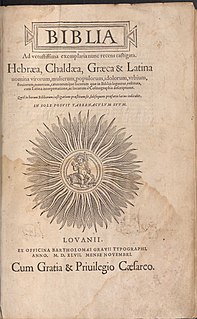 W
WThe Leuven Vulgate or Hentenian Bible is an edition of the Vulgate which was edited by Hentenius (1499–1566) and published in Louvain in 1547. This edition was republished several times, and in 1574 a revised edition was published.
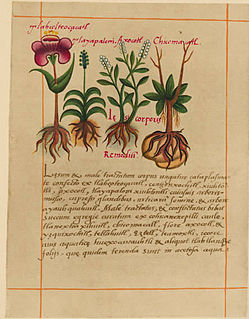 W
WThe Libellus de Medicinalibus Indorum Herbis is an Aztec herbal manuscript, describing the medicinal properties of various plants used by the Aztecs. It was translated into Latin by Juan Badiano, from a Nahuatl original composed in the Colegio de Santa Cruz de Tlatelolco in 1552 by Martín de la Cruz that is no longer extant. The Libellus is also known as the Badianus Manuscript, after the translator; the Codex de la Cruz-Badiano, after both the original author and translator; and the Codex Barberini, after Cardinal Francesco Barberini, who had possession of the manuscript in the early 17th century.
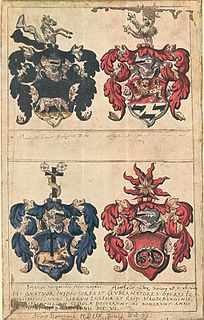 W
WThe Magdeburg Centuries is an ecclesiastical history, divided into thirteen centuries, covering thirteen hundred years, ending in 1298; it was first published from 1559 to 1574. It was compiled by several Lutheran scholars in Magdeburg, known as the Centuriators of Magdeburg. The chief of the Centuriators was Matthias Flacius. Lutheran theologian Werner Elert argued that due to its revolutionary critical method of presenting history, it is the basis of all modern church history.
 W
WMagia Naturalis is a work of popular science by Giambattista della Porta first published in Naples in 1558. Its popularity ensured it was republished in five Latin editions within ten years, with translations into Italian (1560), French, (1565) Dutch (1566) and English (1658) printed.
 W
WMysterium Cosmographicum is an astronomy book by the German astronomer Johannes Kepler, published at Tübingen in 1597 and in a second edition in 1621. Kepler proposed that the distance relationships between the six planets known at that time could be understood in terms of the five Platonic solids, enclosed within a sphere that represented the orbit of Saturn.
 W
WThe Paraphrases were Latin Biblical paraphrases, rewritings of the Gospels by Desiderius Erasmus. Composed between 1517 and 1524, Erasmus occasionally revised them until his death in 1536.
 W
WPhysica speculatio is a text of scientific character written by Alonso de la Vera Cruz in 1557 in the capital of New Spain. It was the first published work in the American continent that specifically addressed the study of physics, and was written to teach the students of the Real University of Mexico.
 W
WPiae Cantiones ecclesiasticae et scholasticae veterum episcoporum is a collection of late medieval Latin songs first published in 1582. It was compiled by Jacobus Finno, a clergyman who was headmaster of the cathedral school at Turku. Publication was undertaken by Theodoricus Petri Rutha of Nyland, who lived from about 1560 to about 1630. He came from an aristocratic family in Finland, and was educated at Rostock.
 W
WThe Plantin Polyglot is a polyglot Bible, printed under the title Biblia Polyglotta by Christopher Plantin in Antwerp (Belgium) between 1568 and 1573.
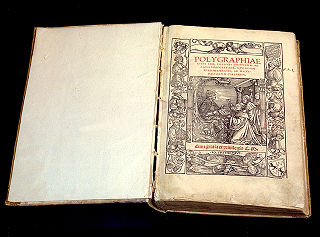 W
WPolygraphia is a cryptographic work written by Johannes Trithemius published in 1518 dedicated to the art of steganography.
 W
WPromptuarium Iconum Insigniorum is an iconography book by Guillaume Rouillé. Its title means ‘Promptuary (Handbook) of the Images of the Renowned [People]’.
 W
WThe Prophecy of the Popes is a series of 112 short, cryptic phrases in Latin which purport to predict the Roman Catholic popes, beginning with Celestine II. It was first published in 1595 by Benedictine monk Arnold Wion, who attributed the prophecy to Saint Malachy, a 12th-century archbishop of Armagh.
 W
WLes Prophéties is a collection of prophecies by French physician Nostradamus, the first edition of which appeared in 1555 by the publishing house Macé Bonhomme. His most famous work is a collection of poems, quatrains, united in ten sets of verses ("Centuries") of 100 quatrains each.
 W
WThe Prutenic Tables, were an ephemeris by the astronomer Erasmus Reinhold published in 1551. They are sometimes called the Prussian Tables after Albert I, Duke of Prussia, who supported Reinhold and financed the printing. Reinhold calculated this new set of astronomical tables based on Nicolaus Copernicus' De revolutionibus orbium coelestium, the epochal exposition of Copernican heliocentrism published in 1543. Throughout his explanatory canons, Reinhold used as his paradigm the position of Saturn at the birth of the Duke, on 17 May 1490. With these tables, Reinhold intended to replace the Alfonsine Tables; he added redundant tables to his new tables so that compilers of almanacs familiar with the older Alfonsine Tables could perform all the steps in an analogous manner.
 W
WPsalmi da Vidici ad Hebraicam veritatem castigati is a printed psaltery authored by Thomas Cajetan and printed in Venice in 1530. It contains fragments of the Old Testament and specifically praises God and his laws. Most of it is made up of psalms attributed to King David, which were to be read in accordance with the rules of the ecclesiastical liturgy.
 W
WThe Sixtine Vulgate or Sistine Vulgate is the edition of the Vulgate—a 4th-century Latin translation of the Bible that was written largely by Jerome—which was published in 1590, prepared by a commission on the orders of Pope Sixtus V and edited by himself. It was the first edition of the Vulgate authorised by a pope. Its official recognition was short-lived; the edition was replaced in 1592 by the Sixto-Clementine Vulgate.
 W
WThe Sixto-Clementine Vulgate or Clementine Vulgate is the edition promulgated in 1592 by Pope Clement VIII of the Vulgate—a 4th-century Latin translation of the Bible that was written largely by Jerome. It was the second edition of the Vulgate to be authorised by the Catholic Church, the first being the Sixtine Vulgate. The Sixto-Clementine Vulgate was used officially in the Catholic Church until 1979, when the Nova Vulgata was promulgated by Pope John Paul II.
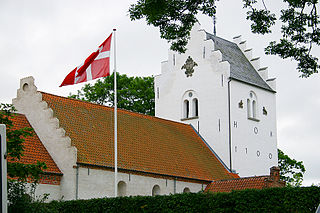 W
WThe Skibby Chronicle is a Danish chronicle written in Latin and dating from the 1530s. The original manuscript was found during 1650, walled in behind the altar of Skibby Church. It was printed in Latin 1773 and translated into Danish 1890-1891.
 W
WTheatrum Orbis Terrarum is considered to be the first true modern atlas. Written by Abraham Ortelius, strongly encouraged by Gillis Hooftman and originally printed on 20 May 1570 in Antwerp, it consisted of a collection of uniform map sheets and supporting text bound to form a book for which copper printing plates were specifically engraved. The Ortelius atlas is sometimes referred to as the summary of sixteenth-century cartography. The publication of the Theatrum Orbis Terrarum (1570) is often considered as the official beginning of the Golden Age of Netherlandish cartography.
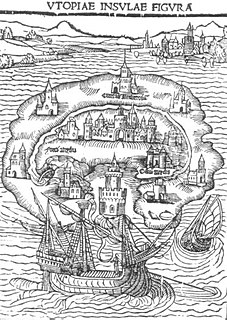 W
WUtopia is a work of fiction and socio-political satire by Thomas More (1478–1535), written in Latin and published in 1516. The book is a frame narrative primarily depicting a fictional island society and its religious, social, and political customs. Many aspects of More's description of Utopia are reminiscent of life in monasteries.